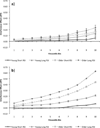Age-related changes in attentional selection: quality of task set or degradation of task set across time?
- PMID: 23834491
- PMCID: PMC3979426
- DOI: 10.1037/a0033159
Age-related changes in attentional selection: quality of task set or degradation of task set across time?
Abstract
The present study explores the nature of attentional selection in younger and older adults. Following R. De Jong, E. Berendsen, and R. Cools (1999, Acta Psychologica, Vol. 101, pp. 379-394), we manipulated the response to stimulus interval (RSI) in two attentional selection paradigms to examine if there are age-related differences in the quality of task set and/or the maintenance of task set across time. In Experiment 1, we found that the interference effect in a spatial interference task was (a) overall larger in older adults compared with younger adults, and (b) smaller at the short RSI (200 ms) compared with the long RSI (2000 ms), and (c) not associated with an interaction between age and RSI. The second experiment explored the same variables in a Stroop color interference paradigm. Again, older adults produced a disproportionately larger interference effect than younger adults, the interference effect was smaller at the short RSI compared with the long RSI, and there was no evidence of an interaction between age and RSI. In both experiments, the larger interference effect could not be attributed to age-related general slowing and there was evidence from Vincentile analyses of increasing interference and age effects at the slower response latencies. These results indicate that attentional selection deficits in these two experiments were due to a breakdown in the quality of the task set as opposed to age-related differences in the maintenance of the task set across time.
Figures
References
-
- Balota DA, Dolan PO, Duchek JM. Memory changes in healthy older adults. In: Tulving E, Craik FIM, editors. The Oxford Handbook of Memory. New York: Oxford University Press; 2000. pp. 395–409.
-
- Balota DA, Yap MJ, Cortese MJ, Watson JM. Beyond mean response latency: Response time distributional analysis of semantic priming. Journal of Memory and Language. 2008;59:495–523. http://dx.doi.org/10.1016/j.jml.2007.10.004. - DOI
-
- Balota DA, Yap MJ. Moving beyond the mean in studies of mental chronometry: The power of response time distributional analyses. Current Directions in Psychological Science. 2011;20(3):160–166.
-
- Castel AD, Balota DA, Hutchison KA, Logan JM, Yap MJ. Spatial attention and response control in healthy younger and older adults and individuals with Alzheimer's disease: Evidence for disproportionate selection impairments in the Simon task. Neuropsychology. 2007;21(2):170. - PubMed
-
- De Jong R. Adult age differences in goal activation and goal maintenance. European Journal of Cognitive Psychology. 2001;13(1–2):71–89.
Publication types
MeSH terms
Grants and funding
LinkOut - more resources
Full Text Sources
Other Literature Sources
Medical
Miscellaneous



